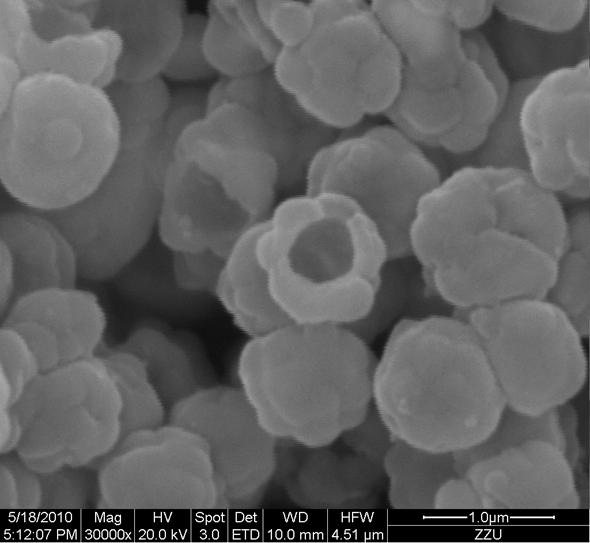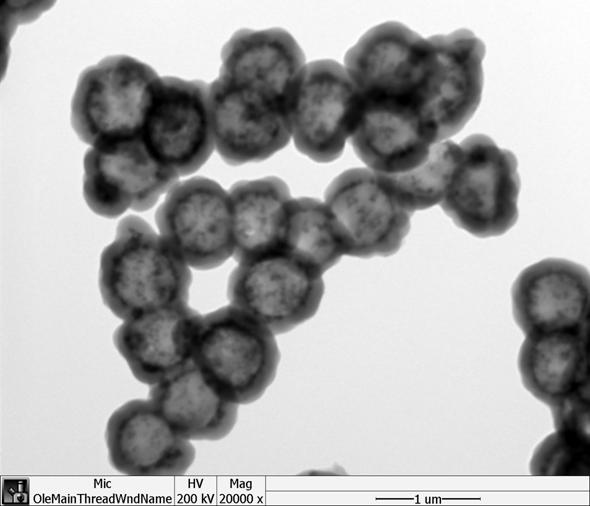Hollow polyphosphazenes microsphere with magnetic particles embedded in casing layer and preparation method thereof
A magnetic particle and polyphosphazene technology, which is applied in the field of biomaterials and new materials, can solve the problems of dispersing inside the hollow ball and destroying the outer polymer structure, etc., and achieves controllable inner diameter, highly cross-linked chemical structure, and easy operation Effect
- Summary
- Abstract
- Description
- Claims
- Application Information
AI Technical Summary
Problems solved by technology
Method used
Image
Examples
Embodiment 1
[0026] (1) Add 0.04 g of polystyrene microspheres with an average particle size of 600 nm into a single-mouth bottle containing 60 mL of absolute ethanol, and place the single-mouth bottle in an ultrasonic reactor for 10 minutes to make the polystyrene microspheres dissolve in absolute ethanol. disperse evenly; then add 0.08 g hexachlorocyclotriphosphazene, 0.176 g 4,4′-dihydroxydiphenyl sulfone and 0.01 g Fe 3 o 4 (average particle size 10nm), disperse uniformly under ultrasonic conditions (100 W, 40 kHz), and finally add acid-binding agent 4 mL triethylamine, and ultrasonically react for 10 h at 40 °C. After the reaction, it was separated by centrifugation, washed twice with ethanol and deionized water, and vacuum-dried at 50°C for 24 hours to obtain composite microspheres with polystyrene as the core and polyphosphazene with embedded magnetic particles as the shell.
[0027] (2) Add the above-obtained composite microspheres with a core-shell structure into a container cont...
Embodiment 2
[0035] (1) Add 0.02 g of polystyrene microspheres with an average particle size of 400 nm into a single-mouth bottle containing 30 mL of absolute ethanol, and place the single-mouth bottle in an ultrasonic reactor for 10 minutes to make the polystyrene microspheres dissolve in absolute ethanol. disperse evenly; then add 0.01 g hexachlorocyclotriphosphazene, 0.02 g 4,4′-dihydroxydiphenyl sulfone and 0.005 g Fe 3 o 4 (average particle size 5nm), disperse uniformly under ultrasonic conditions (100 W, 40 kHz), and finally add acid-binding agent 1mL triethylamine, and ultrasonically react at 20°C for 10 h. After the reaction, it was separated by centrifugation, washed twice with ethanol and deionized water, and vacuum-dried at 70°C for 20 hours to obtain composite microspheres with polystyrene as the core and polyphosphazene with embedded magnetic particles as the shell.
[0036] (2) Add the above-obtained composite microspheres with a core-shell structure into a container contain...
Embodiment 3
[0039] (1) Add 0.1 g of polystyrene microspheres with an average particle size of 900 nm into a single-mouth bottle containing 300 mL of absolute ethanol, and place the single-mouth bottle in an ultrasonic reactor for 10 minutes to make the polystyrene microspheres dissolve in absolute ethanol. disperse evenly; then add 0.1 g hexachlorocyclotriphosphazene, 0.2 g 4,4′-dihydroxydiphenyl sulfone and 0.025 g Fe 3 o 4 (average particle size 50nm), disperse uniformly under ultrasonic conditions (100 W, 40 kHz), and finally add acid-binding agent 10mL triethylamine, and ultrasonically react at 60°C for 3 h. After the reaction, it was separated by centrifugation, washed twice with ethanol and deionized water, and vacuum-dried at 80°C for 12 hours to obtain composite microspheres with polystyrene as the core and polyphosphazene with embedded magnetic particles as the shell.
[0040] (2) Add the composite microspheres with a core-shell structure obtained above into a container containi...
PUM
| Property | Measurement | Unit |
|---|---|---|
| particle diameter | aaaaa | aaaaa |
| particle diameter | aaaaa | aaaaa |
| thickness | aaaaa | aaaaa |
Abstract
Description
Claims
Application Information
 Login to View More
Login to View More - R&D
- Intellectual Property
- Life Sciences
- Materials
- Tech Scout
- Unparalleled Data Quality
- Higher Quality Content
- 60% Fewer Hallucinations
Browse by: Latest US Patents, China's latest patents, Technical Efficacy Thesaurus, Application Domain, Technology Topic, Popular Technical Reports.
© 2025 PatSnap. All rights reserved.Legal|Privacy policy|Modern Slavery Act Transparency Statement|Sitemap|About US| Contact US: help@patsnap.com



